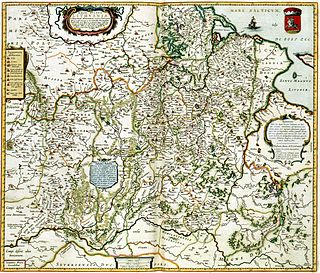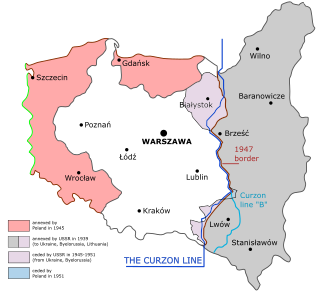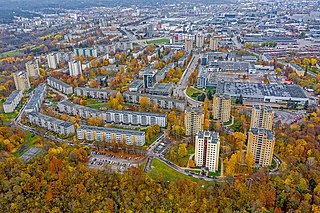
The history of Lithuania dates back to settlements founded about 10,000 years ago, but the first written record of the name for the country dates back to 1009 AD. Lithuanians, one of the Baltic peoples, later conquered neighboring lands and established the Grand Duchy of Lithuania in the 13th century. The Grand Duchy was a successful and lasting warrior state. It remained fiercely independent and was one of the last areas of Europe to adopt Christianity. A formidable power, it became the largest state in Europe in the 15th century spread from the Baltic Sea to the Black Sea, through the conquest of large groups of East Slavs who resided in Ruthenia. In 1385, the Grand Duchy formed a dynastic union with Poland through the Union of Krewo. Later, the Union of Lublin (1569) created the Polish–Lithuanian Commonwealth. During the Second Northern War, the Grand Duchy sought protection under the Swedish Empire through the Union of Kėdainiai in 1655. However, it soon returned to being a part of the Polish–Lithuanian state, which persisted until 1795 when the last of the Partitions of Poland erased both independent Lithuania and Poland from the political map. After the dissolution, Lithuanians lived under the rule of the Russian Empire until the 20th century, although there were several major rebellions, especially in 1830–1831 and 1863.

Vilnius is the capital of and largest city in Lithuania and the second-most populous city in the Baltic states. As of January 2024, Vilnius' estimated population was 602,430, and the Vilnius urban area which extends beyond the city limits had an estimated population of 708,627.

Kernavė was a medieval capital of the Grand Duchy of Lithuania and today is a tourist attraction and an archeological site. It is located in the Širvintos district municipality located in southeast Lithuania. A Lithuanian state cultural reserve was established in Kernavė in 1989. In 2004 Kernavė Archaeological Site was included into UNESCO world heritage list.

Music of Lithuania refers to all forms of music associated with Lithuania, which has a long history of the folk, popular and classical musical development. Music was an important part of polytheistic, pre-Christian Lithuania – rituals were accompanied by music instruments and singing, deeds of the heroes and those who didn't return from the war were celebrated in songs.

Eastern Borderlands or simply Borderlands was a term coined for the eastern part of the Second Polish Republic during the interwar period (1918–1939). Largely agricultural and extensively multi-ethnic with a Polish minority, it amounted to nearly half of the territory of interwar Poland. Historically situated in the eastern Polish–Lithuanian Commonwealth, following the 18th-century foreign partitions it was divided between the Empires of Russia and Austria-Hungary, and ceded to Poland in 1921 after the Treaty of Riga. As a result of the post-World War II border changes, all of the territory was ceded to the USSR, and none of it is in modern Poland.

Vilnius University is a public research university, which is the first and largest university in Lithuania, as well as one of the oldest and most prominent higher education institutions in Central and Eastern Europe. Today, it is Lithuania's leading research institution.

The kanklės is a Lithuanian plucked string instrument (chordophone) belonging to the Baltic box zither family known as the Baltic psaltery, along with the Latvian kokles, Estonian kannel, Finnish kantele, and Russian gusli.

Vilnius Region is the territory in present-day Lithuania and Belarus that was originally inhabited by ethnic Baltic tribes and was a part of Lithuania proper, but came under East Slavic and Polish cultural influences over time.

Rumšiškės is a Lithuanian town, situated 20 km (12 mi) east of Kaunas on the northern bank of Kaunas Reservoir. Southern part of the town is now under the waters of the artificial lake. The 18th century St. Michael Archangel church of Rumšiškės was saved and moved to its present place in 1958, when the reservoir was created.

Verkiai Palace is an 18th-century neoclassical mansion in Verkiai, Vilnius, Lithuania.

Žirmūnai is the most populous administrative division (elderate) in Vilnius. It is also a neighbourhood in the Lithuanian capital city Vilnius, encompassing the city district of the same name, built in the 1960s.
The national symbols of Lithuania are used in Lithuania and abroad to represent the country and its people, history, culture, and nature. These symbols are seen in official capacities, such as flags, coats of arms, postage stamps, and currency, and in URLs. They appear less formally as recurring themes in literature, art and folk art, heraldry, monuments, clothing, personal decoration, and as the names of parks, bridges, streets, and clubs. The less formal manifestations may be classified as national emblems.

The Poles in Lithuania, also called Lithuanian Poles, estimated at 183,000 people in the Lithuanian census of 2021 or 6.5% of Lithuania's total population, are the country's largest ethnic minority.

Suvalkija or Sudovia is the smallest of the five cultural regions of Lithuania. Its unofficial capital is Marijampolė. People from Suvalkija are called suvalkiečiai (plural) or suvalkietis (singular) in Lithuanian. It is located south of the Neman River, in the former territory of Vilkaviškis bishopric. Historically, it is the newest ethnographic region as its most distinct characteristics and separate regional identity formed during the 19th century when the territory was part of Congress Poland. It was never a separate political entity and even today it has no official status in the administrative division of Lithuania. However, it continues to be the subject of studies focusing on Lithuanian folk culture of the 19th and early 20th centuries.

Culture of Lithuania combines an indigenous heritage, represented by the unique Lithuanian language, with Nordic cultural aspects and Christian traditions resulting from historical ties with Poland. Although linguistic resemblances represent strong cultural ties with Latvia in various historical moments Lithuania was influenced by Nordic, Germanic and Slavic cultures. Various cultural changes occurred throughout Lithuania's transformation from a country occupied by the Soviet Union to an independent Baltic state. The culture of Lithuania can be divided into five ethnographic regions: Dzūkija, Samogitia, Aukštaitija, Sudovia and Mažoji Lietuva.

Vytautas Miškinis is a Lithuanian composer, choral conductor and academic teacher. He is artistic director of Ąžuoliukas, a boys' and youth choir and music school, and of other ensembles, performing internationally. He has taught choral conducting at the Lithuanian Academy of Music and Theatre from 1985. His groups have won prizes at international competitions, where he also served as member of the jury. His compositions are part of international standard choral repertoire.

Paulius Galaunė was a Lithuanian art historian, museum curator, and graphic artist. He was one of the first professional museum curators in Lithuania and was well-published on topics of Lithuanian folk art. The apartment of Galaunė and his wife Adelė Nezabitauskaitė, an opera singer, was converted into the Galaunė Family Museum in 1995, and contains his personal belongings as well as his works. It is part of the M. K. Čiurlionis National Art Museum. He was buried in Petrašiūnai Cemetery.
The Ukrainians in Lithuania numbered 14,168 persons at the 2021 Lithuanian census, and at 0.5% of the total population of Lithuania. The Ukrainian national minority in Lithuania has deep historical and cultural relations. Many prominent figures of Ukraine such as Taras Shevchenko, Meletius Smotrytsky, Yakiv Holovatsky, St. Yosafat and others stayed and created in Lithuania.

The Christianization of Lithuania occurred in 1387, initiated by King of Poland and Grand Duke of Lithuania Jogaila and his cousin Vytautas the Great. It signified the official adoption of Christianity by Lithuania, the last pagan country in Europe. This event ended one of the most complicated and lengthiest processes of Christianization in European history.

Tatar population in Lithuania is an ethnic group living in the Republic of Lithuania historical lands of Lithuania. It is also considered one of the oldest ethnic minorities in Lithuania.


















